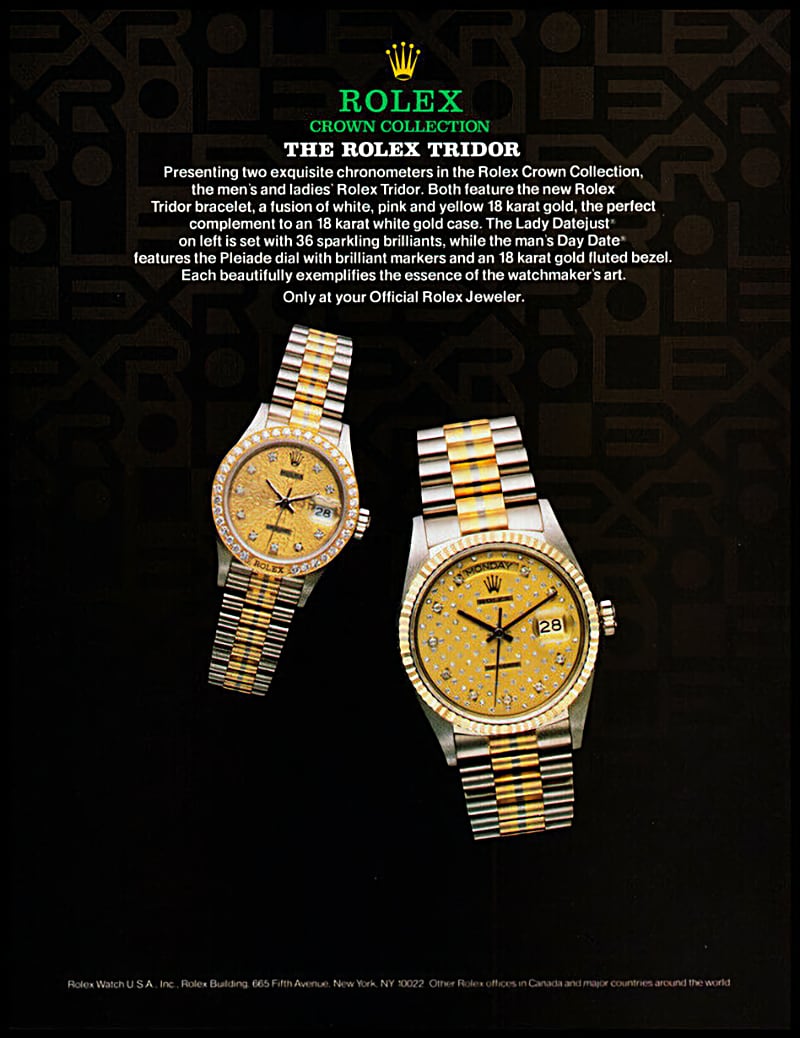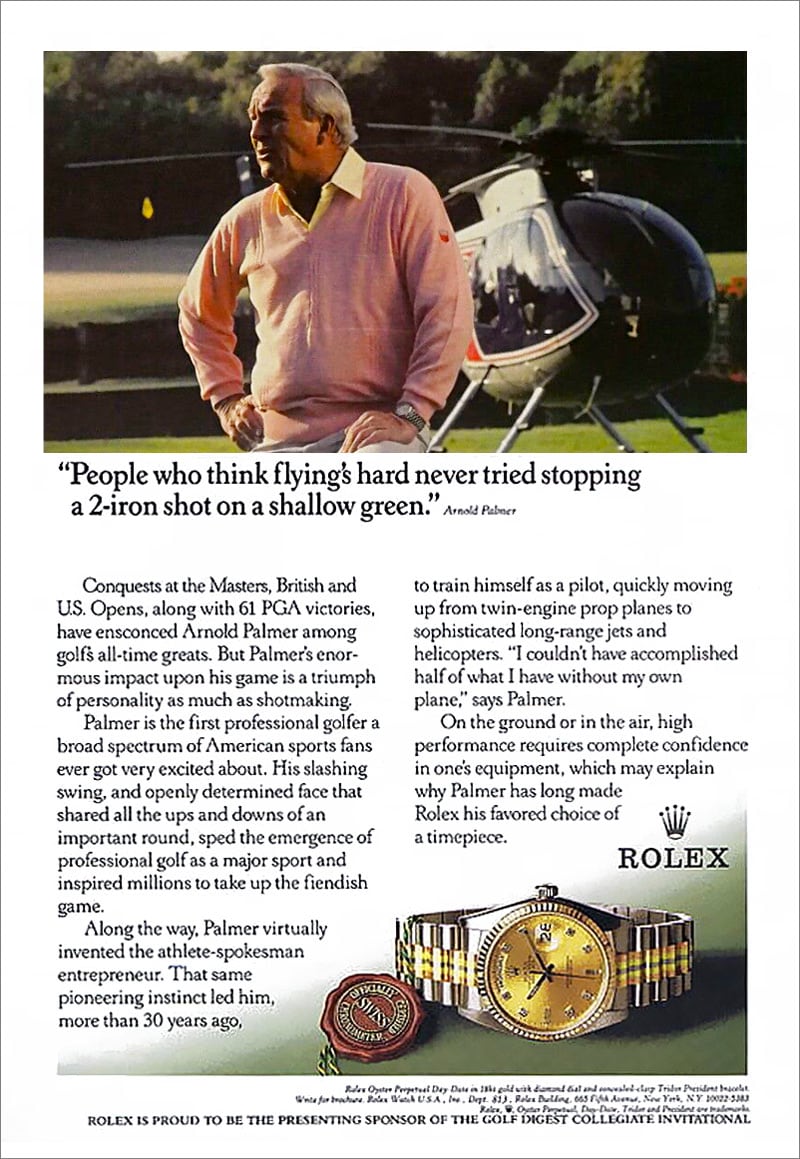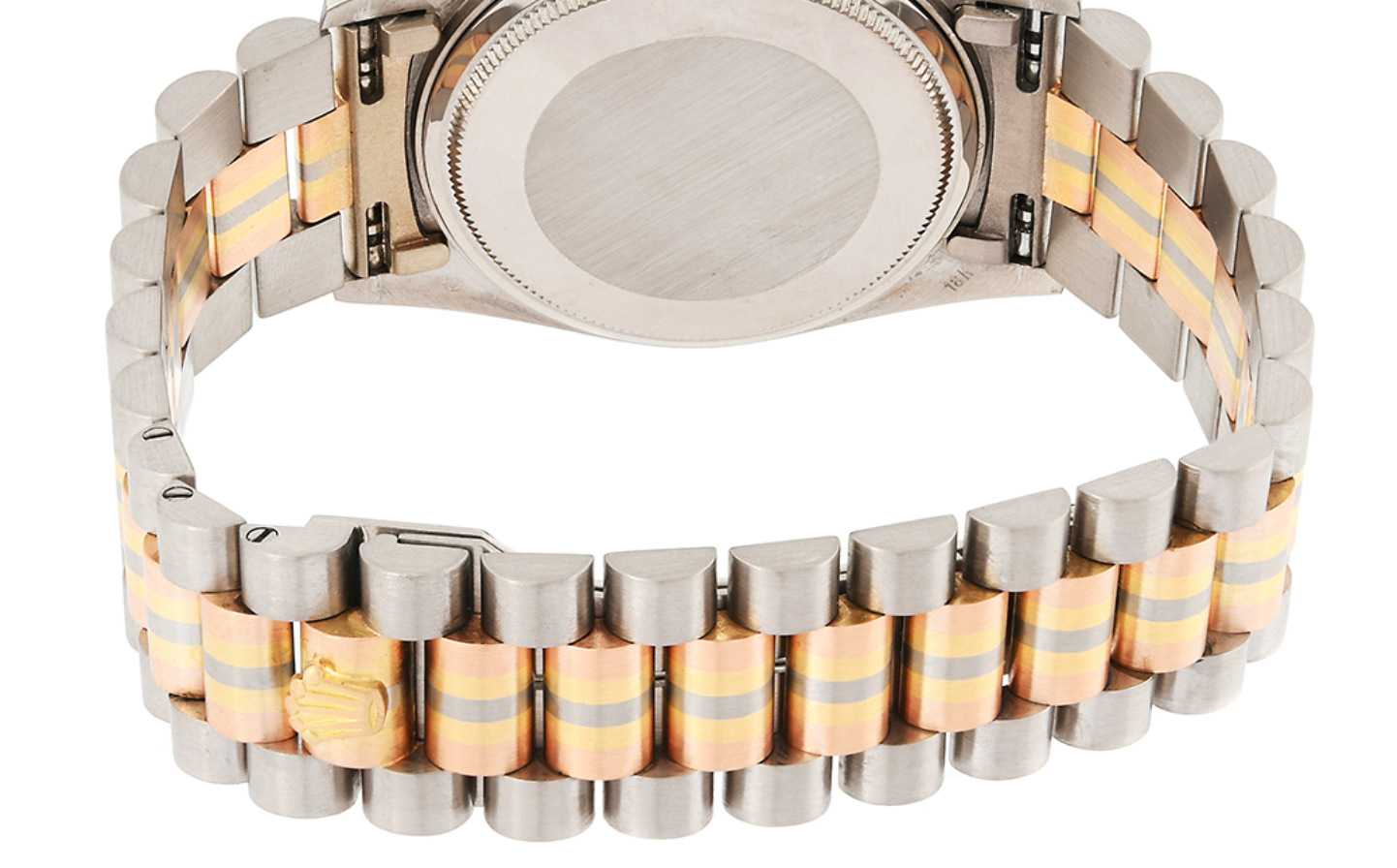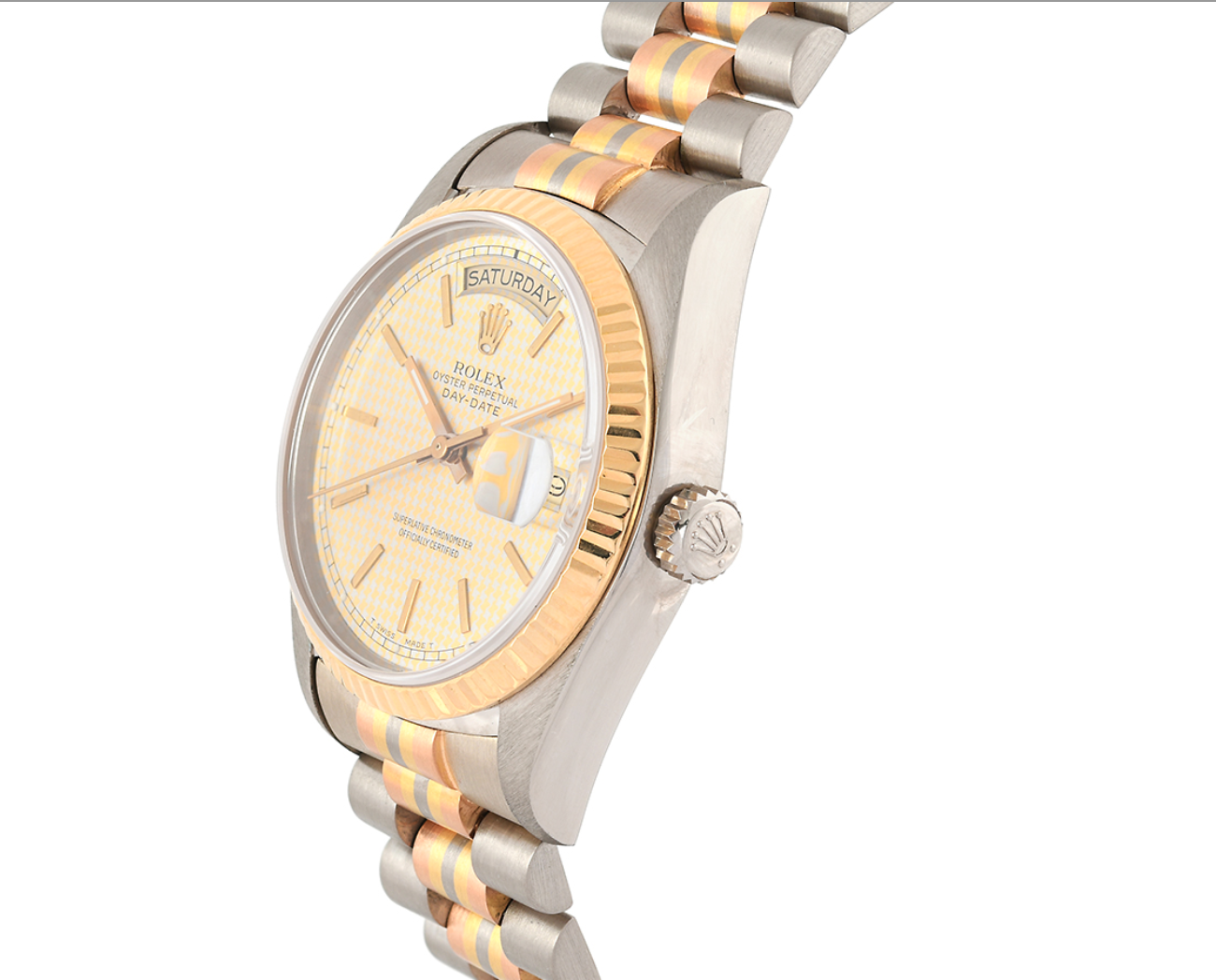
What is Rolex Tridor? Complete Guide
Rolex is a company that does things a lot differently from most of its competitors. One of the things that Rolex puts particular emphasis on is developing new and proprietary materials – which are then given proprietary names. What this does is allow Rolex to make its watches appear more unique, special, and rare. Rolex can highlight the fact that its watches use unique in-house developed materials that cannot be found in any other watches. This naturally creates a sense of scarcity and rarity that makes Rolex watches stand out from the rest.
Rolex invests a lot of resources into research and development – far more than most other brands. And this is not only for show, either. By working to develop new materials and material combinations, Rolex can ensure that the material they use have the exact properties that they want. This is especially true if such material doesn’t yet exist on the market. For example, Rolex makes its own yellow gold and rose gold alloys(the latter known as Everose Gold) with the perfect blend to give them the look that they want but also to prevent tarnishing and ensure longevity.
The material we are looking closer at in this article is Rolex Tridor. Tridor is technically not a material but rather a unique combination of materials that give a completely unique and distinct look.

What is Rolex Tridor?
Rolex Tridor is a material that consists of three types of gold, yellow gold, white gold, and pink gold. Tridor is not just a blend of materials in the sense that the golds haven’t just been put into a pot and blended into a mix but rather, they have been seamlessly integrated against each other to create a distinct and unique gold pattern where different types of gold meet each other.
In a broader sense, the term ”Tridor”, whilst it is a proprietary term coined by Rolex to refer to this gold blend, is also used to describe the watch models that use this metal combination, for example, ”Day-Date Tridor”.
Since Tridor is a gold blend, all Tridor watches are made in full gold. This includes every single part of the watch, from the bracelet to the case.
The name Tridor is rather self-explanatory for this gold blend as ”tri” means three, and three types of gold are used. The term ”Two-tone” is widely used in the watch industry and so Tridor could technically be called ”three-tone”.

When Rolex created Tridor, it was seen as quite an impressive feat. Seamlessly blending different types of gold together is a difficult process that requires great precision. Bear in mind that gold when it is melted reaches extreme temperatures and is liquid, making it an extreme challenge to achieve the precision required to achieve the Tridor creations. As a matter of fact, at the time, no other watch brand had been able to create such a blend, but through dedicated research and development, Rolex eventually succeeded.
If you look closely at a Tridor President bracelet, you’ll understand what we mean. The gold isn’t just mashed together but rather has a clear and distinct contrast where one gold meets the other, beautifully melted together to also ensure a robust construction.

For the watches that use Tridor, it really is the bracelet that is the highlight of the show. Whilst it would technically be possible to create the same blend for the, for example, case, Rolex focused on using the blend on the bracelet, and then just making different parts of the actual watch in different types of gold. In practice, this means that the case is made of white gold, the bezel is made of yellow gold, and the crown is made of white gold. The choice of making different parts of the actual watch in different materials makes more sense and also creates a more seamless look together with the Tridor bracelet.
Rolex released Tridor in 1977 for the Day-Date, which makes sense considering the fact that it is a model that is solely made of precious metal. During the late 1970s and early 1980s, there was a trend around mixing and matching different types of gold, which is also the reason why many watch companies (including Rolex) focused a lot on two-tone watches. But with the launch of the Tridor, Rolex uses a whopping three types of gold to create a watch with a truly unique look. The trend of tri-gold was very hot in jewelry and that is probably where Rolex got the idea of making a watch with the same concept.
The first Tridor was based on the 18039, which was the full white gold Day-Date 36 that the company produced at the time. By changing a few of the parts to other metals than gold, and adding a Tridor President bracelet, Rolex was able to achieve a luxury watch made in full gold with a truly unique appearance. The Tridor was given the reference 18039BIC.

To create the Tridor blend for the bracelet, Rolex melts the three different types of gold to create a seamless pattern that stretches all the way across the whole bracelet.
For some, the Rolex Day-Date Tridor was a way for those who wanted a full gold watch to get something truly unique. For others, it was perhaps a good choice when you couldn’t make your mind up about whether you should choose white gold, rose gold, or yellow gold watch. At the same time, in terms of looks, the Tridor strikes a balance between understated class and luxury. Whilst a full yellow gold watch can be rather flashy and hard to miss, a white gold watch may be perceived as too boring and discreet according to some. With that said, you could say that the Tridor combines the best of both worlds with a watch that sits somewhere in between and is neither boring nor too flashy.
For the Tridor bracelet, the outer links are made in 18k white gold to match the case. The center links, on the other hand, are made with a combination of 18k pink gold on the outside with white gold in the middle, and yellow gold in between.

Rolex Day-Date and the Tridor models
Before we dig into the intricacies of the Tridor models, let’s begin at the very beginning, namely the birth of the Day-Date.
Rolex launched the Day-Date, later nicknamed the ”President” due to the fact that several presidents wore this watch, including Eisenhower. The Day-Date was and still is exclusively made in precious metal (today, platinum, yellow gold, and Everose gold) and was the first watch to feature a date function and a calendar function (that is, a watch that shows the day of the week on the dial). The Day-Date, being made exclusively in solid gold, was naturally a luxury watch, mostly intended for world leaders, wealthy individuals, and successful businessmen. And considering the fact that there were no iPhones around at this time, having a day and a date function was very practical for individuals who worked hectic schedules and needed to keep track of the time, day, and date.
The Day-Date was first launched in 1956 and has therefore been around for quite some time now. Almost seven decades to be exact. And what is most interesting is the fact that whilst this model has been revised, updated, and improved many times throughout the decades, its core design looks very similar to the original. In fact, the untrained eye would have a hard time noticing any major difference between the original 36mm Day-Date and the current one. This just goes to show how truly timeless the Day-Date is. It is literally a watch that has stood the test of time. That alone is an impressive feat that most watches are not able to brag with.
As already stated, the first Tridor Rolex Day-Date was launched in 1977 with the reference 18039BIC.
In 1988, Rolex upgraded the current Day-Date line by replacing the 1803X reference with 1823X reference. The key upgrade was that Rolex added the double-quickset function (with caliber 3155, which replaced the single-quickset caliber 3055) which allows the wearer to adjust the day and the date individually without having to change the time which is a very practical function to have.

With that said, the Tridor Day-Date was available as both the single-quickset reference, 18039BIC, and the double-quickset reference, 18239BIC.
The Tridor was eventually discontinued in the year 2000 but the Tridor would actually come to return in a different shape and form under the Pearlmaster collection. In the case of the Pearlmaster, however, the gold is not melted together for the bracelet. Instead, it has individual links in different metals so technically, it is not a true Tridor watch, albeit it uses all of the three gold types.
In total, the Day-Date had a production run of more than 20 years before finally being discontinued.
The production years for Rolex models can vary depending on the source you look at but the production years below are the official production years that Rolex states in its own records.
Rolex Tridor models
- 18039BIC – Produced between 1977 and 1990
- 18129BIC – Produced between 1985 and 1990 (an 18039 with diamond-set bezel)
- 18239BIC – Produced between 1989 and 2000
- 18349BIC – Produced between 1989 and 2000 (available with Tridor President bracelet or two-tone Jubilee bracelet with diamond-set middle links)
Other Rolex Tridor models
A lot of people believe that the Day-Date is the only model that was made with the Tridor three-metal design but that is actually not the case. At the same time, it is understandable since the Day-Date was the star of the show and also the Tridor watch that was produced in the most numbers. In fact, Rolex also made several Datejust and Lady Datejust models with the Tridor design. The other Tridor models are quite rare and are not something that most people come across that often.
The other Rolex Tridor references include:
- Datejust 68419BIC (diamond bezel)
- Datejust 78289BIC (diamond bezel)
- Datejust 78279BIC
- Datejust 68279 (available with Tridor President bracelet or two-tone Jubilee bracelet with diamond-set middle links)
- Datejust 68289BIC (diamond bezel, available with Tridor President bracelet or two-tone Jubilee bracelet with diamond-set middle links)
- Lady Datejust 79179BIC
- Lady Datejust 79139BIC (diamond bezel)
- Lady Datejust 69179BIC
- Lady Datejust 69149BIC (available with Tridor President bracelet or two-tone Jubilee bracelet with diamond-set middle links)
- Lady Datejust 69139BIC (available with Tridor President bracelet or two-tone Jubilee bracelet with diamond-set middle-links)
Availability of the Rolex Tridor
Because the Tridor was a rather unique watch, it sold in considerably fewer examples than its yellow gold counterparts (which has long been the classic material for the Day-Date). When most people thought about the Day-Date, they thought about a yellow-gold one (which was what all the presidents had been wearing as well). In addition, it’s safe to say that the Tridor has a funky look that doesn’t appeal to everyone.
For that reason, the total production numbers of the Tridor Day-Date are considerably lower than that for other materials. Therefore, the Tridor is a bit of a rare bird today. Whilst they’re not as rare as some other models which only surface on the market every once in a while, there are considerably fewer of them on the market than the yellow gold counterpart. As a result, Tridor watches tend to cost slightly more. At the same time, the Tridor is a watch that splits opinions and therefore, the demand isn’t quite there in the same way. If it would, considering the relatively low production numbers, the Tridor would command a much higher premium than it does today.
Conclusion
Today, Rolex is known for being very conservative. But the Rolex back in the day was not quite as conservative. Those who appreciate the Rolex Tridor can be happy about this as we perhaps wouldn’t otherwise have been blessed with the unique and truly social Tridor Day-Date that Rolex created.
In summary, Rolex Tri-Color Gold, or Tridor, is a proprietary gold alloy used by Rolex in some of its watches. The alloy combines yellow, white, and rose gold to create a unique and distinctive appearance. The use of Tri-Color Gold is a symbol of high craftsmanship and attention to detail and it is a unique combination from Rolex that we haven’t seen from the company since it was discontinued in the year 2000.
Main photo courtesy of Kaplans.se.




